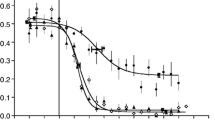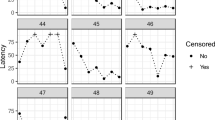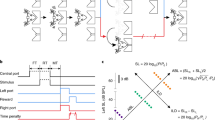Abstract
A mechanism with properties of discrimination and conditioning is discussed mathematically with reference to special cases in the problem of error elimination: elimination of the longer of two paths to a goal, elimination of a blind as well as a return alley, and Lashley's jumping problem. For each case equations are derived which are qualitatively correct as far as was determined. Several qualitative deductions are made and these are substantiated by data available. In principle, the theory makes it possible to predict, for any trial, the number of errors at any junction of a maze provided certain experimental conditions are satisfied, and if a sufficient number of experimental values are given to determine the parameters of the system.
Similar content being viewed by others
Literature
Gulliksen, H. 1934. “A Rational Equation of the Learning Curve Based on Thorndike's Law of Effect.”J. Gen. Psy.,11, 395–434.
Gulliksen, H. and Wolfle, D. L. 1938. “A Theory of Learning and Transfer: I.”Psychometrika,3, 127–149.
Hull, C. L. 1934. “The Goal Gradient Hypothesis and Maze Learning.”Psychol. Rev.,39, 25–43.
Landahl, H. D. 1938a. “A Contribution to the Mathematical Biophysics of Psychophysical Discrimination.”Psychometrika,3, 107–125.
Landahl, H. D. 1938b. “Contribution to the Mathematical Biophysics of Error Elimination.”Psychometrika,3, 169–180.
Landahl, H. D. 1939. “A Contribution to the Mathematical Biophysics of Psychophysical Discrimination II.”Bull. Math. Biophysics,1, 156–176.
Peterson, J. 1917. “The Effect of Length of Blind on Maze Learning.”Behavior Monographys,3, No. 4.
Rashevsky, N. 1936. “Mathematical Biophysics of Delayed Reflexes in Connection with the Theory of Error Elimination.”Psychometrika,1, 265–273.
Rashevsky, N. 1938.Mathematical Biophysics. Chicago: The University of Chicago Press.
Thurstone, L. L. 1927. “A Law of Comparative Judgment.”Psychol. Rev.,34, 273–286.
Thurstone, L. L. 1930. “The Learning Function.”J. Gen. Psychol.,3, 469–493.
Thurstone, L. L. 1933. “The Error Function in Maze Learning.”J. Gen. Psychol. 9, 288–301.
Author information
Authors and Affiliations
Rights and permissions
About this article
Cite this article
Landahl, H.D. Studies in the mathematical biophysics of discrimination and conditioning I. Bulletin of Mathematical Biophysics 3, 13–26 (1941). https://doi.org/10.1007/BF02478103
Issue Date:
DOI: https://doi.org/10.1007/BF02478103




